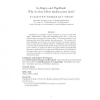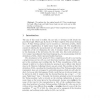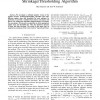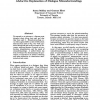499 search results - page 20 / 100 » Why neighbor-joining works |
IM
2007
13 years 9 months ago
2007
PageRank is a popularity measure designed by Google to rank Web pages. Experiments confirm that PageRank values obey a power law with the same exponent as In-Degree values. This ...
CSL
1999
Springer
13 years 9 months ago
1999
Springer
We explain why the original proofs of P-Time completeness for Light Affine Logic and Light Linear Logic can not work, and we fully develop a working one.
TSP
2010
13 years 4 months ago
2010
We investigate a subband adaptive version of the popular iterative shrinkage/thresholding algorithm that takes different update steps and thresholds for each subband. In particular...
PEPM
1999
ACM
14 years 2 months ago
1999
ACM
Quasiquotation is the technology commonly used in Lisp to write program-generating programs. In this paper I will review the history and development of this technology, and explai...
EACL
1993
ACL Anthology
13 years 11 months ago
1993
ACL Anthology
To respond to an utterance, a listener must interpret what others have said and why they have said it. Misunderstandings occur when agents differ in their beliefs about what has b...




